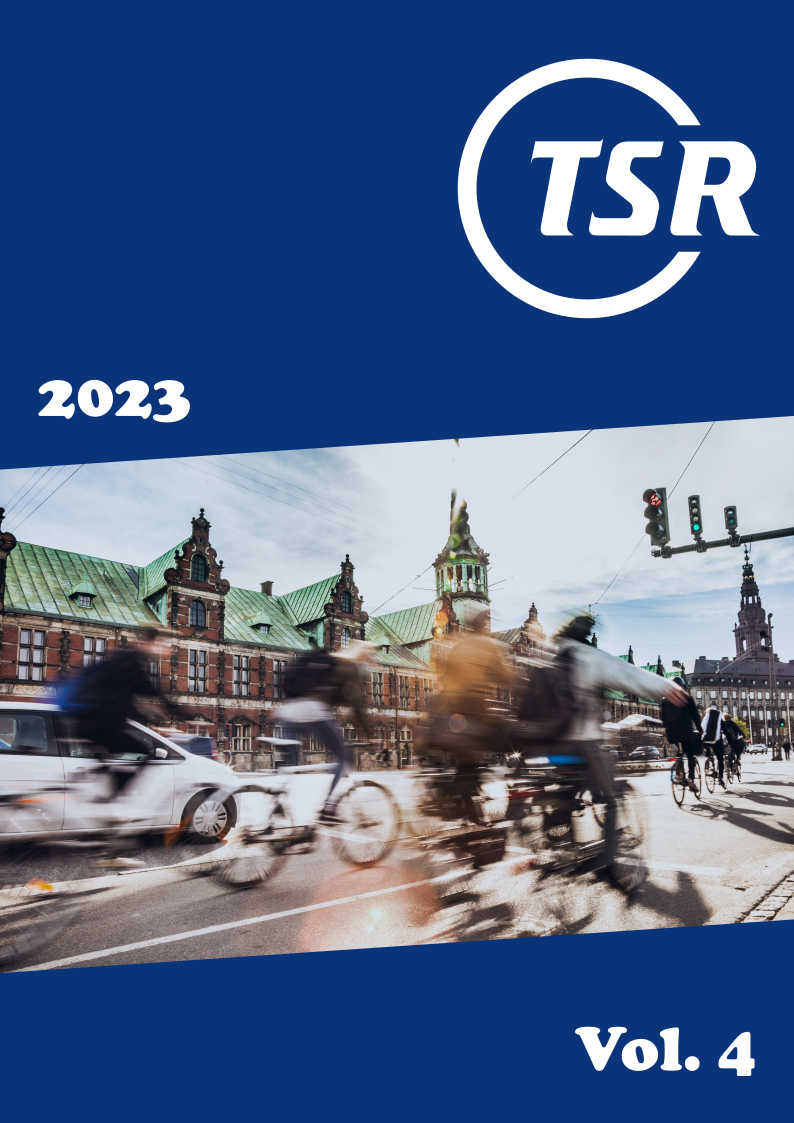Road rage behaviours among road users in Turkey
DOI:
https://doi.org/10.55329/guim6548Keywords:
traffic psychology, road rage, road users, traffic safetyAbstract
One of the human-caused factors that decreases traffic safety is road rage behaviors. Many of the behaviors thought to be indicative of road rage are clearly intended to be aggressive. The purpose of this study was to examine the frequency of road rage incidents experienced by road users both as victims and perpetrators. Furthermore, the goal was to investigate the impact of various and other factors on road rage behaviors in the past year. The questionnaire was completed by 633 individuals who agreed to participate in the study and reside in Istanbul, Izmir, and Ankara. All of the participants were Turkish, aged 19–76 years (M = 37.84 years, SD = 10.10); 57.3% were females, and 42.7% were males. The survey application was started with ethical approval. Using the snowball sampling method, a survey link or paper pencil forms were distributed to participants. Participants were requested to fill out the questionnaire form including information and various forms of road rage. Data were analyzed using the chi-square test and binary logistic regression analysis. Using the SPSS 28 program, all data were statistically analyzed to a significance level of p < 0.05. According to our findings, low-level road rage is most common among road users. For perpetration, this rate is 43.6%, while for victimization it is 63.2%. Overall, the results of the analysis suggest that low or high-levels of road rage perpetration and victimization may be influenced by driving a vehicle, carrying a weapon and certain demographic factors like gender, age, education level, and marital status. Numerous factors interact to facilitate road rage's emergence. In our study, various forms of road rage are significantly influenced by factors such as age, gender, education, marital status, driving a vehicle, carrying a weapon. We believe it is crucial to examine this issue from multiple perspectives. Additionally, programs for prevention and intervention that effectively reduce the prevalence of road rage incidents are critical.
Downloads
References
AAA_Foundation, (2014), 'Prevalence of Self-Reported Aggressive Driving Behavior: United States', AAA Foundation for Traffic Safety.
Aksar, C., T. Alavci (2018), 'Cinsiyetçiligin Sürücü Öfkesi ve Sürücü Öfke Ifadesi ile Iliskisi', Trafik ve Ulasim Arastirmalari Dergisi, 1(1), 69–87. DOI: https://doi.org/10.38002/tuad.418260
Aktas, A. (2021), 'Sürücülerde alkol kullanimi ve yol siddeti (road rage) arasindaki iliskinin incelenmesi', PhD thesis, Ege Üniversitesi.
Aktas, A., S. A. Akgür (2022), 'Yol Siddeti Öyküleri: Bir Nitel Çalisma', Trafik ve Ulasim Arastirmalari Dergisi, 5(1), 1–21. DOI: https://doi.org/10.38002/tuad.1054784
Aktas, A., S. A. Akgür (2022), 'Drinking, drug use and road rage in Turkish drivers', Transportation Research Part F: Traffic Psychology and Behaviour, 89, 16–28. DOI: https://doi.org/10.1016/j.trf.2022.06.012
Anderson, C. A., B. J. Bushman (2002), 'Human Aggression', Annual Review of Psychology, 53(1), 27–51. DOI: https://doi.org/10.1146/annurev.psych.53.100901.135231
Asbridge, M., R. G. Smart, R. E. Mann (2003), 'The homogamy of road rage: understanding the relationship between victimization and offend- ing among aggressive and violent motorists', Violence and Victims, 18(5), 517–531. DOI: https://doi.org/10.1891/vivi.2003.18.5.517
Asbridge, M., R. G. Smart, R. E. Mann (2006), 'Can We Prevent Road Rage?', Trauma, Violence, & Abuse, 7(2), 109–121. DOI: https://doi.org/10.1177/1524838006286689
Azik, D. (2021), 'Road users’ evaluations and perceptions of road infrastructure, trip characteristics, and daily trip experiences across countries', Transportation Research Interdisciplinary Perspectives, 11. DOI: https://doi.org/10.1016/j.trip.2021.100412
Benavidez, D. C. (2013), 'Road rage among drug dependent patients', Accident Analysis & Prevention, 50, 848–853. DOI: https://doi.org/10.1016/j.aap.2012.07.010
Benjamin, A. J., B. J. Bushman (2016), 'The weapons priming effect', Current Opinion in Psychology, 12, 45–48. DOI: https://doi.org/10.1016/j.copsyc.2016.05.003
Berdoulat, E., J. Deninotti, D. Vavassori (2021), 'Typology of aggressive and transgressive drivers', Accident Analysis & Prevention, 162, 106404. DOI: https://doi.org/10.1016/j.aap.2021.106404
Berkowitz, L. (1974), 'Some determinants of impulsive aggression: Role of mediated associations with reinforcements for aggression', Psychological Review, 81(2), 165–176. DOI: https://doi.org/10.1037/h0036094
Berkowitz, L. (1993), Aggression: Its causes, consequences, and control, (New York, NY: McGraw-Hill).
Bjureberg, J., J. J. Gross (2021), 'Regulating road rage', Social and Personality Psychology Compass, 15(3), 1–16. DOI: https://doi.org/10.1111/spc3.12586
Blanchard, E. B., K. A. Barton, L. Malta (2000), 'Psychometric Properties of a Measure of Aggressive Driving: The Larson Driver’s Stress Profile', Psychological Reports, 87(3), 881–892. DOI: https://doi.org/10.2466/pr0.2000.87.3.881
Brewer, A. M. (2000), 'Road rage: What, who, when, where and how?', Transport Reviews, 20(1), 49–64. DOI: https://doi.org/10.1080/014416400295338
Britt, T. W., M. J. Garrity (2003), 'An integrative model of road rage', Revue Internationale de Psychologie Sociale, 16(3), 53–79.
Briz-Redón, Á., F. Martínez-Ruiz, F. Montes (2019), 'Spatial analysis of traffic accidents near and between road intersections in a directed linear network', Accident Analysis & Prevention, 132, 105252. DOI: https://doi.org/10.1016/j.aap.2019.07.028
Bushman, B. J., C. A. Anderson (2001), 'Is it time to pull the plug on hostile versus instrumental aggression dichotomy?', Psychological Review, 108(1), 273–279. DOI: https://doi.org/10.1037//0033-295X.108.1.273
Bushman, B. J., T. Kerwin, T. Whitlock, J. M. Weisenberger (2017), 'The weapons effect on wheels: Motorists drive more aggressively when there is a gun in the vehicle', Journal of Experimental Social Psychology, 73, 82–85. DOI: https://doi.org/10.1016/j.jesp.2017.06.007
Carpenter, J. (2020), 'Kill switch: The evolution of road rage in an increasingly AI car culture', in Pak, R., E. J. de Visser, E. Rovira (eds.), Living with Robots, Elsevier. DOI: https://doi.org/10.1016/B978-0-12-815367-3.00004-9
Cavacuiti, C. (2013), 'Victims of Road Rage: A Qualitative Study of the Experiences of Motorists and Vulnerable Road Users', Violence and Victims, 28(6), 1068–1084. DOI: https://doi.org/10.1891/0886-6708.VV-D-12-00068
Deb, S., L. Strawderman, J. DuBien, B. Smith, D. W. Carruth, T. M. Garrison (2017), 'Evaluating pedestrian behavior at crosswalks: Validation of a pedestrian behavior questionnaire for the U.S. population', Accident Analysis & Prevention, 106, 191–201. DOI: https://doi.org/10.1016/j.aap.2017.05.020
Deffenbacher, J. L., D. M. Deffenbacher, R. S. Lynch, T. L. Richards (2003), 'Anger, aggression, and risky behavior: a comparison of high and low anger drivers', Behaviour Research and Therapy, 41(6), 701–718. DOI: https://doi.org/10.1016/S0005-7967(02)00046-3
Deffenbacher, J. L., R. S. Lynch, E. R. Oetting, R. C. Swaim (2002), 'The Driving Anger Expression Inventory: a measure of how people express their anger on the road', Behaviour Research and Therapy, 40(6), 717–737. DOI: https://doi.org/10.1016/S0005-7967(01)00063-8
Deffenbacher, J. L., E. R. Oetting, R. S. Lynch (1994), 'Development of a Driving Anger Scale', Psychological Reports, 74(1), 83–91. DOI: https://doi.org/10.2466/pr0.1994.74.1.83
Deffenbacher, J. L., A. N. Stephens, M. J. M. Sullman (2016), 'Driving anger as a psychological construct: Twenty years of research using the Driving Anger Scale', Transportation Research Part F: Traffic Psychology and Behaviour, 42, 236–247. DOI: https://doi.org/10.1016/j.trf.2015.10.021
Dukes, R. L. (2001), 'Effects of aggressive driving and driver characteristics on road rage', The Social Science Journal, 38(2), 323–331. DOI: https://doi.org/10.1016/S0362-3319(01)00117-3
Dula, C. S., E. S. Geller (2003), 'Risky, aggressive, or emotional driving: Addressing the need for consistent communication in research', Journal of Safety Research, 34(5), 559–566. DOI: https://doi.org/10.1016/j.jsr.2003.03.004
Dula, C. S., M. E. Ballard (2003), 'Development and Evaluation of a Measure of Dangerous, Aggressive, Negative Emotional, and Risky Driving1', Journal of Applied Social Psychology, 33(2), 263–282. DOI: https://doi.org/10.1111/j.1559-1816.2003.tb01896.x
Ellison, P. A., J. M. Govern, H. L. Petri, M. H. Figler (1995), 'Anonymity and Aggressive Driving Behavior:A Field Study', Journal of Social Behavior & Personality, 10(1), 265–272.
Ellison-Potter, P., P. Bell, J. Deffenbacher (2001), 'The Effects of Trait Driving Anger, Anonymity, and Aggressive Stimuli on Aggressive Driving Behavior', Journal of Applied Social Psychology, 31(2), 431–443. DOI: https://doi.org/10.1111/j.1559-1816.2001.tb00204.x
Esiyok, B., Y. Yasak, I. Korkusuz (2007), 'Trafikte öfke ifadesi: sürücü öfke ifadesi envanteri’nin geçerlik ve güvenilirlig?i', Türk Psikiyatri Dergisi, 18(3), 231–243.
Evans, L. (2004), Traffic Safety, Science Serving Society.
Fierro, I., C. Morales, F. J. Álvarez (2011), 'Alcohol use, illicit drug use, and road rage', Journal of Studies on Alcohol and Drugs, 72(2), 185–193. DOI: https://doi.org/10.15288/jsad.2011.72.185
Fong, G., D. Frost, S. Stansfeld (2001), 'Road rage: A psychiatric phenomenon?', Social Psychiatry and Psychiatric Epidemiology, 36, 277–286. DOI: https://doi.org/10.1007/s001270170045
Galovski, T. E., E. B. Blanchard (2002), 'The effectiveness of a brief psychological intervention on court-referred and self-referred aggressive drivers', Behaviour Research and Therapy, 40(12), 1385–1402. DOI: https://doi.org/10.1016/S0005-7967(01)00100-0
Gaygisiz, E. (2010), 'Cultural values and governance quality as correlates of road traffic fatalities: A nation level analysis', Accident Analysis & Prevention, 42(6), 1894–1901. DOI: https://doi.org/10.1016/j.aap.2010.05.010
Giarratana, C. (2019), Will Autonomous Cars Spark A New Form Of Road Rage?.
Granié, M.-A., M. Pannetier, L. Guého (2013), 'Developing a self-reporting method to measure pedestrian behaviors at all ages', Accident Analysis & Prevention, 50, 830–839. DOI: https://doi.org/10.1016/j.aap.2012.07.009
Güngör, A., M. Tütenkan, G. Solmazer, B. Tekes (2020), 'Emotion Regulation Strategies and Driving Anger Expression: The Moderating Role of Gender', Nesne Psikoloji Dergisi.
Guo, F., Y. Fang (2013), 'Individual driver risk assessment using naturalistic driving data', Accident Analysis & Prevention, 61, 3–9. DOI: https://doi.org/10.1016/j.aap.2012.06.014
Hemenway, D., M. Vriniotis, M. Miller (2006), 'Is an armed society a polite society? Guns and road rage', Accident Analysis & Prevention, 38(4), 687–695. DOI: https://doi.org/10.1016/j.aap.2005.12.014
Herrero-Fernández, D., S. Fonseca-Baeza (2017), 'Angry thoughts in Spanish drivers and their relationship with crash-related events. The mediation effect of aggressive and risky driving', Accident Analysis & Prevention, 106, 99–108. DOI: https://doi.org/10.1016/j.aap.2017.05.015
Hussain, B., H. Sato, T. Miwa, T. Morikawa (2020), 'Influence of personality traits on aberrant driving behaviors: A comparison of Japanese, Chinese, and Vietnamese drivers', Journal of Safety Research, 75, 178–188. DOI: https://doi.org/10.1016/j.jsr.2020.09.011
Indermaur, D. (1998), 'Preventing driving related violence', 7th international seminar on environmental criminology and crime analysis, Barcelona, Spain, 21–24 June 1998.
Joint, M. (1995), 'Road rage', Automobile Association.
Joo, Y.-J. (2022), 'A data-driven Bayesian network for probabilistic crash risk assessment of individual driver with traffic violation and crash records', Accident Analysis & Prevention, 176. DOI: https://doi.org/10.1016/j.aap.2022.106790
Jovanovic, D., K. Lipovac, P. Stanojevic, D. Stanojevic (2011), 'The effects of personality traits on driving-related anger and aggressive behaviour in traffic among Serbian drivers', Transportation Research Part F: Traffic Psychology and Behaviour, 14(1), 43–53. DOI: https://doi.org/10.1016/j.trf.2010.09.005
Kenrick, D. T., S. W. MacFarlane (1986), 'Ambient Temperature and Horn Honking', Environment and Behavior, 18(2), 179–191. DOI: https://doi.org/10.1177/0013916586182002
Kölbel, R. (2003), 'Violence on the Roads', International Handbook of Violence Research, (Dordrecht, Germany: Springer). DOI: https://doi.org/10.1007/978-0-306-48039-3_46
Krahé, B., I. Fenske (2002), 'Predicting aggressive driving behavior: The role of macho personality, age, and power of car', Aggressive Behavior, 28(1), 21–29. DOI: https://doi.org/10.1002/ab.90003
Lajunen, T., D. Parker, H. Summala (1999), 'Does traffic congestion increase driver aggression?', Transportation Research Part F: Traffic Psychology and Behaviour, 2(4), 225–236. DOI: https://doi.org/10.1016/S1369-8478(00)00003-6
Lajunen, T., D. Parker, S. G. Stradling (1998), 'Dimensions of driver anger, aggressive and highway code violations and their mediation by safety orientation in UK drivers', Transportation Research Part F: Traffic Psychology and Behaviour, 1(2), 107–121. DOI: https://doi.org/10.1016/S1369-8478(98)00009-6
Lawton, R., A. Nutter (2002), 'A comparison of reported levels and expression of anger in everyday and driving situations', British Journal of Psychology, 93(3), 407–423. DOI: https://doi.org/10.1348/000712602760146521
Lee, Y.-C., D. J. Bonfiglio (2013), 'What is stressful on the road? Analysis on aggression-inducing traffic situations through self-report', Proceedings of the Human Factors and Ergonomics Society Annual Meeting, 57, 1500–1503. DOI: https://doi.org/10.1177/1541931213571334
Lupton, D. (2002), 'Road rage: drivers’ understandings and experiences', Journal of Sociology, 38(3), 275–290. DOI: https://doi.org/10.1177/144078302128756660
Mako, E., P. Szakonyi (2016), 'Evaluation of Human Behaviour at Pedestrian Crossings', Transportation Research Procedia, 14, 2121–2128. DOI: https://doi.org/10.1016/j.trpro.2016.05.227
Mann, R. E. (2004), 'Alcohol consumption and problems among road rage victims and perpetrators', Journal of Studies on Alcohol, 65(2), 161–168. DOI: https://doi.org/10.15288/jsa.2004.65.161
Mann, R. E., J. Zhao, G. Stoduto, E. M. Adlaf, R. G. Smart, J. E. Donovan (2007), 'Road rage and collision involvement', American Journal of Health Behavior, 31(4), 384–391. DOI: https://doi.org/10.5993/AJHB.31.4.5
Miller, M., D. Azrael, D. Hemenway, F. I. Solop (2002), '“Road rage” in Arizona: armed and dangerous', Accident Analysis & Prevention, 34(6), 807–814. DOI: https://doi.org/10.1016/S0001-4575(01)00080-X
Møller, M., S. Haustein (2018), 'Road anger expression-Changes over time and attributed reasons', Accident Analysis & Prevention, 119, 29–36. DOI: https://doi.org/10.1016/j.aap.2018.06.013
NHTSA, (2022), 'Early Estimate of Motor Vehicle Traffic Fatalities for the First Half (January – June) of 2022', National Center for Statistics and Analysis. National Highway Traffic Safety Administration, DOT HS 813 376.
Orhan, G., Ö. B. Yeter (2019), 'Bir Iç Güvenlik Sorunu Olarak Bireysel Silahlanma: Türkiye Için Durum Degerlendirmesi Ve Politika Alternatifleri', ASSAM Uluslararasi Hakemli Dergi 13. Uluslararasi Kamu Yönetimi Sempozyumu Bildirileri Özel Sayisi, 130–143.
Özkan, T., T. Lajunen (2011), 'Person and environment: Traffic culture', in B. E. Porter, (ed.), Handbook of Traffic Psychology, (San Diego, CA, USA: Elsevier). DOI: https://doi.org/10.1016/B978-0-12-381984-0.10014-1
Özkan, T., T. Lajunen, D. Parker, N. Sümer, H. Summala (2011), 'Aggressive driving among British, Dutch, Finnish and Turkish drivers', International Journal of Crashworthiness, 16(3), 233–238. DOI: https://doi.org/10.1080/13588265.2010.536687
Öztürk, I., Ö. Bahar (2021), 'Investigating Young Male and Female Road Users’ Behaviour as Pedestrians and Drivers', Psikoloji Çalismalari / Studies in Psychology, 41(2), 581–614. DOI: https://doi.org/10.26650/SP2020-0045
Öztürk, I., Ö. Özkan, Ö. Bahar (2021), 'Investigating sex, masculinity and femininity in relation to impulsive driving and driving anger expression', Transportation Research Part F: Traffic Psychology and Behaviour, 81, 14–26. DOI: https://doi.org/10.1016/j.trf.2021.05.009
Papadimitriou, E. (2019), 'Review and ranking of crash risk factors related to the road infrastructure', Accident Analysis & Prevention, 125, 85–97. DOI: https://doi.org/10.1016/j.aap.2019.01.002
Papadimitriou, E., A. Theofilatos, G. Yannis (2013), 'Patterns of pedestrian attitudes, perceptions and behaviour in Europe', Safety Science, 53, 114–122. DOI: https://doi.org/10.1016/j.ssci.2012.09.008
Pfeiffer, J.-L., K. Pueschel, D. Seifert (2016), 'Interpersonal violence in road rage. Cases from the Medico-Legal Center for Victims of Violence in Hamburg', Journal of Forensic and Legal Medicine, 39, 42–45. DOI: https://doi.org/10.1016/j.jflm.2015.11.023
Weina, Q., H. Zhang, W. Zhao, K. Zhang, G. Yan (2016), 'The effect of cognitive errors, mindfulness and personality traits on pedestrian behavior in a Chinese sample', Transportation Research Part F: Traffic Psychology and Behaviour, 41, 29–37. DOI: https://doi.org/10.1016/j.trf.2016.06.009
Rathbone, D. B., J. C. Huckabee (1999), 'Controlling Road Rage: A Literature Review and Pilot Study', AAA Foundation for Traffic Safety. DOI: https://doi.org/10.1037/e363912004-001
Rosenbloom, T., D. Nemrodov, H. Barkan (2004), 'For heaven’s sake follow the rules: pedestrians’ behavior in an ultra-orthodox and a non-orthodox city', Transportation Research Part F: Traffic Psychology and Behaviour, 7(6), 395–404. DOI: https://doi.org/10.1016/j.trf.2004.10.004
Sarkar, S. (2000), 'Spatial and Temporal Analyses of Observed and Reported Variations', Transportation Research Record: Journal of the Transportation Research Board, 1724(1), 7–13. DOI: https://doi.org/10.3141/1724-02
Shinar, D. (1998), 'Aggressive driving: the contribution of the drivers and the situation', Transportation Research Part F: Traffic Psychology and Behaviour, 1(2), 137–160. DOI: https://doi.org/10.1016/S1369-8478(99)00002-9
Smart, R. G., R. E. Mann (2002), 'Deaths and injuries from road rage: Cases in Canadian newspapers', Canadian Medical Association Journal, 167(7), 761–762.
Smart, R. G., R. E. Mann, G. Stoduto (2003), 'The Prevalence of Road Rage: Estimates from Ontario', Canadian Journal of Public Health, 94(4), 247–250. DOI: https://doi.org/10.1007/BF03403543
Smart, R. G., G. Stoduto, R. E. Mann, E. M.Adlaf (2004), 'Road Rage Experience and Behavior: Vehicle, Exposure, and Driver Factors', Traffic Injury Prevention, 5(4), 343–348. DOI: https://doi.org/10.1080/15389580490509482
Smart, R. G., E. Cannon, A. Howard, P. Frise, R. E. Mann (2005), 'Can we design cars to prevent road rage?', International Journal of Vehicle Information and Communication Systems, 1(1/2). DOI: https://doi.org/10.1504/IJVICS.2005.007585
Smart, R. G., R. E. Mann, J. Zhao, G. Stoduto (2005), 'Is road rage increasing? Results of a repeated survey', Journal of Safety Research, 36(2), 195–201. DOI: https://doi.org/10.1016/j.jsr.2005.03.005
Smart, R. G. (2007), 'Road Rage Victimization Among Adolescents', Journal of Adolescent Health, 41(3), 277–282. DOI: https://doi.org/10.1016/j.jadohealth.2007.04.013
Solmazer, G. (2020), 'Cross-cultural differences in pedestrian behaviors in relation to values: A comparison of five countries', Accident Analysis & Prevention, 138. DOI: https://doi.org/10.1016/j.aap.2020.105459
Stephens, A., M. Fitzharris (2019), 'The frequency and nature of aggressive acts on Australian roads', Journal of the Australasian College of Road Safety, 30(3), 27–36. DOI: https://doi.org/10.33492/JACRS-D-18-00293B
Stephens, A. N., J. A. Groeger (2011), 'Anger-congruent behaviour transfers across driving situations', Cognition & Emotion, 25(8), 1423–1438. DOI: https://doi.org/10.1080/02699931.2010.551184
Sullman, M. J.M., M. E. Gras, M. Cunill, M. Planes, S. Font-Mayolas (2007), 'Driving anger in Spain', Personality and Individual Differences, 42(4), 701–713. DOI: https://doi.org/10.1016/j.paid.2006.08.014
Sullman, M. J. M., A. N. Stephens, D. Kuzu (2013), 'The expression of anger amongst Turkish taxi drivers', Accident Analysis & Prevention, 56, 42–50. DOI: https://doi.org/10.1016/j.aap.2013.03.013
Sümer, N., T. Lajunen, T. Özkan (2005), 'Big Five Personality Traits as the Distal Predictors of Road Accident Involvement', Traffic and Transport Psychology, Elsevier. DOI: https://doi.org/10.1016/B978-008044379-9/50173-4
Temel, M. (2019), 'Trafik Güvenligini Tehlikeye Sokma', Marmara Üniversitesi (Turkey), Postgraduate thesis (TCK 179/3).
TSI, (2021), 'Road Traffic Accident Statistics, 2020', Turkish Statistical Institute.
Underwood, G., P. Chapman, S. Wright, D. Crundall (1999), 'Anger while driving', Transportation Research Part F: Traffic Psychology and Behaviour, 2(1), 55–68. DOI: https://doi.org/10.1016/S1369-8478(99)00006-6
Vanlaar, W., H. Simpson, D. Mayhew, R. Robertson (2008), 'Aggressive driving: A survey of attitudes, opinions and behaviors', Journal of Safety Research, 39(4), 375–381. DOI: https://doi.org/10.1016/j.jsr.2008.05.005
Wells-Parker, E. (2002), 'An exploratory study of the relationship between road rage and crash experience in a representative sample of US drivers', Accident Analysis & Prevention, 34(3), 271–278. DOI: https://doi.org/10.1016/S0001-4575(01)00021-5
WHO, (2018), 'Global Status Report on Road Safety', World Health Organization.
WHO, (2018), 'Road traffic injuries', World Health Organization.
WHO, (2015), 'Global Status Report on Road Safety 2015', World Health Organization.
Wickens, C. M., R. E. Mann, G. Stoduto, J. E. Butters, A. Ialomiteanu, R. G. Smart (2012), 'Does gender moderate the relationship between driver aggression and its risk factors?', Accident Analysis & Prevention, 45, 10–18. DOI: https://doi.org/10.1016/j.aap.2011.11.013
Wickens, C. M., R. E. Mann, G. Stoduto, A. Ialomiteanu, R. G. Smart (2011), 'Age group differences in self-reported aggressive driving perpetration and victimization', Transportation Research Part F: Traffic Psychology and Behaviour, 14(5), 400–412. DOI: https://doi.org/10.1016/j.trf.2011.04.007
Wickens, C. M., D. L. Wiesenthal (2007), 'State Driver Stress as a Function of Occupational Stress, Traffic Congestion, and Trait Stress Susceptibility', Journal of Applied Biobehavioral Research, 10(2), 83–97. DOI: https://doi.org/10.1111/j.1751-9861.2005.tb00005.x
Xiaolin, W., Y. Wang, Z. Peng, Q. Chen (2018), 'A questionnaire survey on road rage and anger-provoking situations in China', Accident Analysis & Prevention, 111, 210–221. DOI: https://doi.org/10.1016/j.aap.2017.12.003
Jiang, Y., P. C. Evans, L. Perfetti (2004), 'Road aggression among drinking drivers: Alcohol and non-alcohol effects on aggressive driving and road rage', Journal of Criminal Justice, 32, 421–430. DOI: https://doi.org/10.1016/j.jcrimjus.2004.06.004
Yüksel, Y., H. Tosun, Durna (2013), 'Köse Yazarlari Gözüyle Türkiye’de', International Journal of Human Sciences, 10(2), 718–750.
Zhang, T., A. H. S. Chan (2016), 'The association between driving anger and driving outcomes: A meta-analysis of evidence from the past twenty years', Accident Analysis & Prevention, 90, 50–62. DOI: https://doi.org/10.1016/j.aap.2016.02.009
Zhang, T., A. H.S. Chan, W. Zhang (2015), 'Dimensions of driving anger and their relationships with aberrant driving', Accident Analysis & Prevention, 81, 124–133. DOI: https://doi.org/10.1016/j.aap.2015.05.005
Published
How to Cite
Issue
Section
License
Copyright (c) 2023 Alev Aktaş, Serap Annette Akgür

This work is licensed under a Creative Commons Attribution 4.0 International License.









